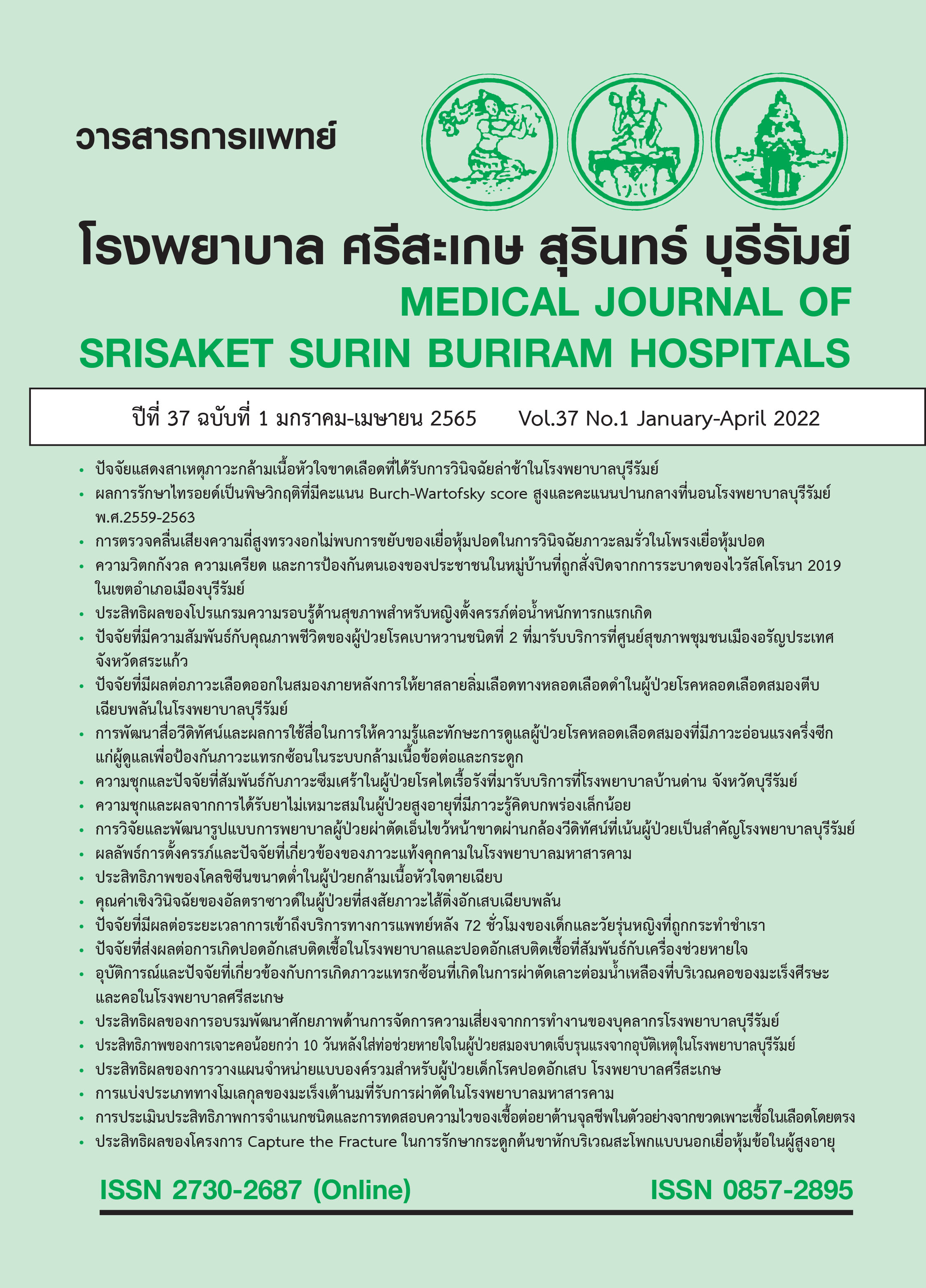ประสิทธิภาพของโครงการ Capture the Fracture ในการรักษากระดูกต้นขาหักบริเวณสะโพกแบบนอกเยื่อหุ้มข้อในผู้สูงอายุ
Main Article Content
บทคัดย่อ
หลักการและเหตุผล: ภาวะกระดูกต้นขาหักบริเวณสะโพกจากอุบัติเหตุในผู้สูงอายุเป็นหนึ่งในการบาดเจ็บหลักของผู้ป่วยทางออร์โธปิดิกส์ เกิดภาวะแทรกซ้อนได้สูง ทำให้สิ้นเปลืองค่าใช้จ่ายในการรักษา รวมทั้งใช้ทรัพยากรในการรักษา และฟื้นฟูมาก ในประเทศไทยได้มีการจัดตั้งโครงการ capture the fracture เพื่อให้มีการผ่าตัดเร็วภายใน 72 ชั่วโมง (3 วัน) เพื่อลดปัญหาดังกล่าวและเพิ่มประสิทธิภาพในการรักษา
วัตถุประสงค์: เพื่อศึกษาประสิทธิภาพของการลดระยะเวลาในการลดเวลารอผ่าตัดจากโครงการ Capture the Fracture ในด้านการลดภาวะแทรกซ้อน ลดระยะเวลานอนโรงพยาบาล และลดค่าใช้จ่ายโดยรวมในการรักษา
วิธีการศึกษา: เป็นการวิจัย intervention research รูปแบบ retrospective observational cohort study รวบรวมข้อมูลผู้ป่วยกระดูกข้อสะโพกหักจากอุบัติเหตุความรุนแรงต่ำ (low energy) อายุมากกว่า 50 ปี ได้รับการวินิจฉัยว่ามีการหักบริเวณตำแหน่งนอกเยื่อหุ้มข้อและได้รับการรักษาด้วยวิธีการผ่าตัดยึดดามกระดูกในโรงพยาบาลสุรินทร์ตั้งแต่มกราคม 2561 ถึงมีนาคม 2564 ผู้ป่วยทุกรายได้รับการผ่าตัดยึดดามกระดูกด้วยอุปกรณ์ proximal femoral nail antirotaion (PFNA) โดยศัลยแพทย์กระดูกและข้อ คัดแยกผู้ป่วยที่มีโรคประจำตัวหรือมีภาวะต้องรอการแก้ไขที่ทำให้ไม่สามารถทำการผ่าตัดได้ทันทีออก แบ่งผู้ป่วยเป็น 2 กลุ่ม คือ กลุ่มที่ได้รับการผ่าตัดภายใน 3 วัน และกลุ่มที่ได้รับการผ่าตัดหลัง 3 วันติดตามระยะเวลานอนโรงพยาบาล ภาวะแทรกซ้อน และค่าใช้จ่ายในการรักษาวิเคราะห์เปรียบเทียบกลุ่มด้วย Chi-squared และ t-tests ปรับตัวแปรรบกวนด้วย multivariable analysis โดยหากค่า p น้อยกว่า0.05 ถือว่าข้อมูลมีความแตกต่างกันอย่างมีนัยสำคัญทางสถิติ
ผลการศึกษา: การศึกษาข้อมูลผู้ป่วยทั้งหมด 226 ราย แบ่งเป็นผู้ป่วยที่ได้รับการผ่าตัดภายใน 3 วัน 105 ราย และกลุ่มที่ได้รับการผ่าตัดหลัง 3 วัน 121 ราย มีอายุตั้งแต่ 50-94 ปี อายุเฉลี่ย 77.5 ปี ด้านของวันนอนรักษาตัวที่โรงพยาบาล กลุ่มที่ได้รับการผ่าตัดเร็ว (ใน 3 วัน) มีระยะเวลานอนโรงพยาบาลรวมสั้นกว่ากลุ่มที่ได้รับการผ่าตัดช้า (หลัง 3 วัน) ชัดเจน (7.05 VS 13.15 วัน) โดยหากพิจารณาเฉพาะระยะเวลานอนโรงพยาบาลหลังผ่าตัดกลุ่มที่ได้รับการผ่าตัดเร็วมีแนวโน้มที่จะกลับบ้านได้เร็วกว่า ด้านค่าใช้จ่ายในการรักษาพยาบาล ผู้ป่วยที่ได้รับการผ่าตัดเร็วมีค่าใช้จ่ายในการรักษาทั้งหมดโดยรวมน้อยกว่าผู้ป่วยที่ได้รับการผ่าตัดช้าอย่างชัดเจน (60343 VS 74296 บาท) เช่นเดียวกับการลดค่าใช้จ่ายในการรักษาหลังหักค่าอุปกรณ์ที่ใช้ในการผ่าตัด ส่วนค่าใช้จ่ายระงับปวดในห้องผ่าตัด กลุ่มที่ได้รับการผ่าตัดเร็วมีแนวโน้มค่าใช้จ่ายที่ต่ำกว่า สำหรับภาวะแทรกซ้อน (complications) จากการเจ็บป่วยในระหว่างการรักษาพบว่าผู้ป่วยที่ได้รับการผ่าตัดเร็ว มีแนวโน้มการเกิดภาวะแทรกซ้อนโดยรวมน้อยกว่าผู้ป่วยที่ได้รับการผ่าตัดช้า (9% VS 20%) โดยภาวะแทรกซ้อนที่พบบ่อย ได้แก่ ทางเดินปัสสาวะติดเชื้อ (UTI) แผลกดทับ(pressure sore) ลิ่มเลือดอุดตัน (VTE) ปอดอักเสบ (pneunonia) เมื่อปรับความแตกต่างพื้นฐานของกลุ่มให้เหมือนกันทางสถิติยังพบว่าระยะเวลานอนโรงพยาบาลและค่าใช่จ่ายในกลุ่มผ่าตัดเร็วมีค่าน้อยกว่าชัดเจน แม้ว่าภาวะแทรกซ้อนไม่ต่างกันทางสถิติ
สรุป: การผ่าตัดผู้ป่วยกระดูกข้อสะโพกหักเร็วตามโครงการ Capture the Fracture สามารถลดวันนอนโรงพยาบาล ลดค่าใช้จ่ายในการรักษารวมทั้งมีแนวโน้มในการลดภาวะแทรกซ้อนของผู้ป่วยได้อย่างมีประสิทธิภาพ
Article Details

อนุญาตภายใต้เงื่อนไข Creative Commons Attribution-NonCommercial-NoDerivatives 4.0 International License.
เอกสารอ้างอิง
Zhang J, Chen X, Wang J, Liu Z, Wang X, Ren J, et al. Poor prognosis after surgery for intertrochanteric fracture in elderly patients with clopidogrel treatment: A cohort study. Medicine (Baltimore) 2017;96(39):e8169. doi: 10.1097/MD.0000000000008169.
Newman B, McCarthy L, Thomas PW, May P, Layzell M, Horn K. A comparison of pre-operative nerve stimulator-guided femoral nerve block and fascia iliaca compartment block in patients with a femoral neck fracture. Anaesthesia 2013;68(9):899-903. doi: 10.1111/anae.12321.
Hefley FG Jr, Nelson CL, Puskarich-May CL. Effect of delayed admission to the hospital on the preoperative prevalence of deep-vein thrombosis associated with fractures about the hip. J Bone Joint Surg Am 1996;78(4):581-3. doi: 10.2106/00004623-199604000-00012.
Hedström M, Gröndal L, Ahl T. Urinary tract infection in patients with hip fractures. Injury 1999;30(5):341-3. doi: 10.1016/s0020-1383(99)00094-7.5.
Versluysen M. How elderly patients with femoral fracture develop pressure sores in hospital. Br Med J (Clin Res Ed) 1986;292(6531):1311-3. doi: 10.1136/bmj.292.6531.1311.
Orosz GM, Magaziner J, Hannan EL, Morrison RS, Koval K, Gilbert M, et al. Association of timing of surgery for hip fracture and patient outcomes. JAMA 2004;291(14):1738-43. doi: 10.1001/jama.291.14.1738.
Kenzora JE, McCarthy RE, Lowell JD, Sledge CB. Hip fracture mortality. Relation to age, treatment, preoperative illness, time of surgery, and complications. Clin Orthop Relat Res 1984;(186):45-56.
Tay E. Hip fractures in the elderly: operative versus nonoperative management. Singapore Med J 2016;57(4):178-81. doi: 10.11622/smedj.2016071.
ศัลยแพทย์ออร์โธปิดิกส์ กระทรวงสาธารณสุข. ร้อยละของโรงพยาบาลที่มีทีม Capture the fracture. [อินเตอร์เน็ท]. [สืบค้นเมื่อ 9 เมษายน 2022]. ค้นได้จาก:URL: https://www.bing.com/search?q=z&form=WNSGPH&qs=SW&cvid=64e3c88a9ac34070a028a36bcf84f8db&pq=z&cc=TH&setlang=en-US&nclid=D6971290331038D42EBB20376672CACA&ts=1649495290324&wsso=Moderate
Hagino H, Endo N, Harada A, Iwamoto J, Mashiba T, Mori S, et al. Survey of hip fractures in Japan: Recent trends in prevalence and treatment. J Orthop Sci 2017;22(5):909-14. doi: 10.1016/j.jos.2017.06.003.
Cooper C, Campion G, Melton LJ 3rd. Hip fractures in the elderly: a world-wide projection. Osteoporos Int 1992;2(6):285-9. doi: 10.1007/BF01623184.
Gullberg B, Johnell O, Kanis JA. World-wide projections for hip fracture. Osteoporos Int 1997;7(5):407-13. doi: 10.1007/pl00004148.
Mattisson L, Bojan A, Enocson A. Epidemiology, treatment and mortality of trochanteric and subtrochanteric hip fractures: data from the Swedish fracture register. BMC Musculoskelet Disord 2018;19(1):369. doi: 10.1186/s12891-018-2276-3.
Keene GS, Parker MJ, Pryor GA. Mortality and morbidity after hip fractures. BMJ 1993;307(6914):1248-50. doi: 10.1136/bmj.307.6914.1248.
Overmann AL, Richards JT, O'Hara NN, D'Alleyrand JC, Slobogean GP. Outcomes of elderly patients with nondisplaced or minimally displaced femoral neck fractures treated with internal fixation: A systematic review and meta-analysis. Injury 2019;50(12):2158-66. doi: 10.1016/j.injury.2019.09.039.
Lawton JO, Baker MR, Dickson RA. Femoral neck fractures--two populations. Lancet 1983;2(8341):70-2. doi: 10.1016/s0140-6736(83)90059-4.
Simunovic N, Devereaux PJ, Sprague S, Guyatt GH, Schemitsch E, Debeer J, et al. Effect of early surgery after hip fracture on mortality and complications: systematic review and meta-analysis. CMAJ 2010;182(15):1609-16. doi: 10.1503/cmaj.092220.
Lizaur-Utrilla A, Gonzalez-Navarro B, Vizcaya-Moreno MF, Miralles Muñoz FA, Gonzalez-Parreño S, Lopez-Prats FA. Reasons for delaying surgery following hip fractures and its impact on one year mortality. Int Orthop 2019;43(2):441-8. doi: 10.1007/s00264-018-3936-5.
Mattisson L, Bojan A, Enocson A. Epidemiology, treatment and mortality of trochanteric and subtrochanteric hip fractures: data from the Swedish fracture register. BMC Musculoskelet Disord 2018;19(1):369. doi: 10.1186/s12891-018-2276-3.
Seong YJ, Shin WC, Moon NH, Suh KT. Timing of Hip-fracture Surgery in Elderly Patients: Literature Review and Recommendations. Hip Pelvis 2020;32(1):11-6. doi: 10.5371/hp.2020.32.1.11.
Klestil T, Röder C, Stotter C, Winkler B, Nehrer S, Lutz M, et al. Impact of timing of surgery in elderly hip fracture patients: a systematic review and meta-analysis. Sci Rep 2018;8(1):13933. doi: 10.1038/s41598-018-32098-7.


